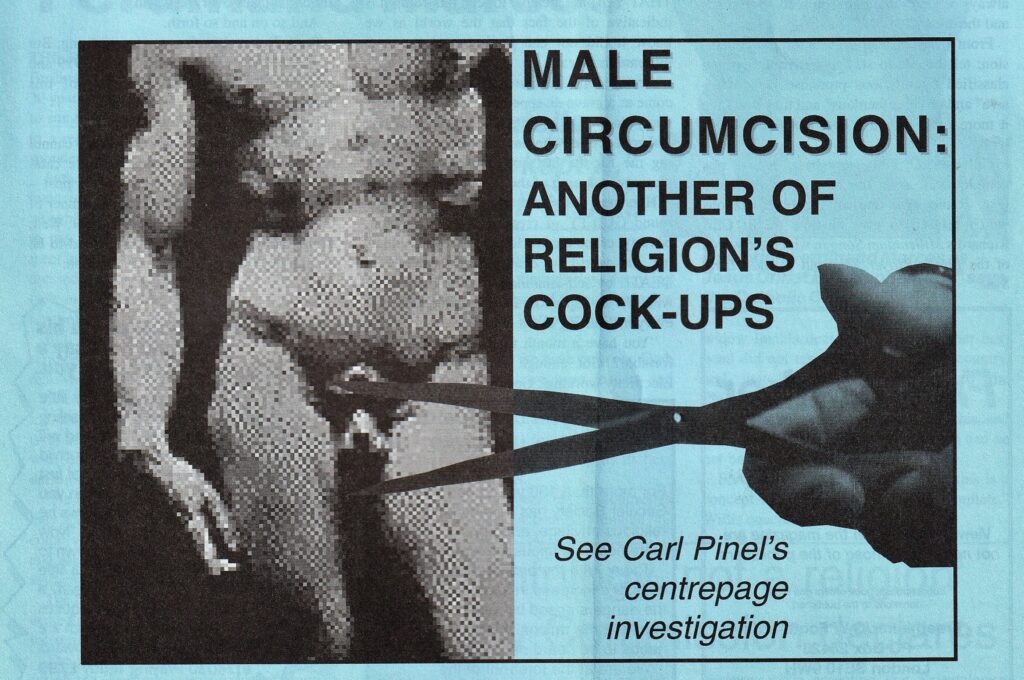
Suppose it were reported that three baby girls had bled to death following Female Genital Mutilation (FGM) in the UK.
Or that a whistleblower had reported that FGM was being carried out by British doctors, leaving girls ‘maimed for life’.
Or that a pharmacist had masqueraded as a girl’s mother in order to subject her to genital cutting but the judge had spared her prison, noting in mitigation that FGM ‘has great cultural and religious significance’ to her.
Readers would rightly be outraged by these incidents. Clearly, girls must be protected from parents who seek to surgically impose their religious or cultural views upon their daughters’ genitals. We naturally abhor these practices which violate bodily autonomy, provide no medical benefit, are rooted in misogyny and explicitly seek to constrain female sexuality.
But here’s the catch: horrors like those described above have actually happened, not to girls who have undergone FGM, but to boys, from circumcision.
Celian Noumbiwe, Angelo Ofori-Mintah, and Goodluck Caubergs were the baby boys who bled to death at the hands of their circumcisers between 2007 and 2012. Circumcision legally performed by British doctors is leaving boys ‘maimed for life’ according to the paediatric surgeon and whistleblower, Shiban Ahmed. Martina Obi-Uzom was the pharmacist entrusted with the care of an 11 month-old boy, only to have him circumcised against his parents’ wishes.
I do not write this article in the spirit of one-upmanship: I am not trying to instigate an ethical arms race between FGM and circumcision. Rather, I would like to persuade you that both practices are morally beyond the pale, and equally worthy of our disapprobation and contempt. In Finland last month, anti-FGM legislation that would have effectively treated FGM and circumcision as comparable practices stalled because a majority of lawmakers refused to accept them as comparable. This kind of failure is what happens when the two practices are treated as morally and legally distinct.
But perhaps there are important distinctions between FGM and circumcision that render them incomparable. After all, circumcision has much-vaunted health benefits. It is, surely, a safe and simple procedure that cannot in good conscience be compared to the barbarism of FGM. And FGM is steeped in patriarchal attitudes; the diminution of the female sexual experience is fundamental to its practice. Can the same be said for circumcision?
The first point can be dealt with quickly: there is not a single medical organisation worldwide that recommends the universal circumcision of newborn boys on health grounds. The much-cited 60% relative risk reduction in female-to-male HIV transmission for circumcised men sounds rather less impressive when converted to an absolute risk reduction of 1.3%. To explain: 1.18% of circumcised men across three trials became infected with HIV compared to 2.49% of controls. This can be reported either as an absolute risk reduction of 1.3% or a relative risk reduction of 60%. The fact is that, even when men are circumcised, condom use remains essential. In the US, where cultural circumcision is routine, HIV rates are higher than in the UK, where the practice remains relatively rare. And as for the so-called ‘hygiene’ argument that a circumcised penis is supposedly cleaner than one that is not, there really is a very simple solution: keep the penis clean by rinsing with water.
Let us turn now to a qualitative comparison of circumcision and FGM. Type 3 FGM, also known as infibulation, is the suturing shut of the vagina. It may also involve the removal of the clitoris. It is typically performed by medically untrained practitioners with non-sterilised equipment. Picture, by contrast, a male circumcision carried out by a doctor, in a hospital, under sterile conditions. Between the brutality of the former and the medicalisation of the latter there is, for the most part, no comparison.
A second comparison, then: the Australian aboriginal practice of subincision, carried out under crude conditions, involves ‘slicing open the urethral passage on the underside of the penis from the scrotum to the glans, often affecting urination as well as sexual function’. By contrast, picture a doctor, in a hospital, under sterile conditions, carrying out a form of FGM called clitoral nicking, which requires only the extraction of a single drop of blood. Again, for the most part, one of these procedures is incomparably more brutal than the other.
Clitoral nicking, however, is commonplace in Malaysia, where up to 99% of Muslim girls undergo FGM and a 2009 fatwa issued by the National Council of Islamic Religious Affairs deemed it obligatory. Ayan Hirsi Ali, an anti-FGM campaigner and herself a victim of FGM, said of the comparison: ‘I think male circumcision is worse than an incision [clitoral nicking] of the girl.’ In case you still have any doubts about the dangers of circumcision, consider the fact that four hundred South African boys died as a result of it between 2008 and 2014 and over half a million were hospitalised.
The point is this: there is a spectrum of invasiveness, harm and medicalisation in both FGM and male genital mutilation. The UK, however, rightly bans all forms of FGM under the Female Genital Mutilation Act 2003, which holds that ‘it is immaterial whether she [the girl in question] or any other person believes that the operation is required as a matter of custom or ritual.’ This includes those forms of FGM which, in the case of Re B and G [2015] , a British judge held were ‘less invasive’ than male circumcision. The judge also ruled that male circumcision constitutes ‘significant harm’ under the Children Act 1989.
Consider, then, the following proposition:
- All forms of FGM are illegal in the UK
- FGM is illegal because it is harmful
- Some forms of FGM are less harmful than male circumcision
- Therefore, male circumcision should be illegal
This is the irresistible legal and moral conclusion to which one is drawn. Unless, that is, you are willing to advocate for the legalisation of those forms of FGM which are less harmful than male circumcision.
In fact, that is exactly what the American Academy of Paediatrics briefly did in 2010: ‘the ritual nick [Type IV FGM] suggested by some paediatricians is not physically harmful and is much less extensive than routine newborn male genital cutting … It might be more effective if federal and state laws enabled pediatricians to reach out to families by offering a ritual nick as a possible compromise to avoid greater harm.’ While it is to the AAP’s eternal shame that they ever proposed legalising ‘less harmful’ forms of FGM, one must, at least, credit the internal consistency of their argument.
* * *
It is uncontroversial that FGM is practised, at least in part, to curb female sexuality. But what of male circumcision? The Sephardic Jewish philosopher Maimonides, considered one of the foremost Torah scholars of the Middle Ages, wrote of circumcision: ‘one of its objects is to limit sexual intercourse … for there is no doubt that circumcision weakens the power of sexual excitement.’ It was, he said, ‘a means for perfecting man’s moral shortcomings. The bodily injury caused to that organ is exactly that which is desired.’
Philo of Alexandria, the Hellenistic Jewish philosopher, concurred: ‘of all the delights which pleasure can afford, the association of man with woman is the most exquisite, it seemed good to the lawgivers to mutilate the organ which ministers to such connections.’ For the avoidance of doubt, both of these men were in favour of circumcision.
Perhaps less well known is that circumcision was also legitimised by the medical establishment of Victorian Britain. According to historian Ronald Hyam:[1] ‘Widely believed to dampen sexual desire, circumcision was seen positively as a means of both promoting chastity and physical health.’ ‘Spermatorrhea’ – an imagined pathology supposedly caused by loss of semen through any means other than marital sex – enjoyed widespread credence. Hence why circumcision, seen as a prophylaxis against masturbation, was an important treatment.
Naturally, these ideas also migrated across the pond. John Harvey Kellogg – of Cornflakes fame – advocated a plain diet and universal neonatal circumcision as a ‘remedy’ to masturbation. In 1894, the Maryland Medical Journal even suggested circumcision as a ‘solution’ to the racist moral panic in America surrounding the possibility of black men attacking white women: ‘the legal enforcement of the circumcision among the negro race would effectually remedy the predisposition to raping inherent in this race.’
It is only since the sexual revolution of the 1960s and ’70s that proponents of circumcision have sought to downplay, rather than emphasise, its effects on male sexuality. But the evidence base for its harms is only growing. The NHS website includes ‘permanent reduction in sensation in the head of the penis, particularly during sex’ as a complication of circumcision. This should come as no surprise given that the foreskin is the most sensitive part of the penis to light touch and warmth. The adult male foreskin contains up to 20,000 erotogenic nerve endings and makes up to 50% of the motile skin of the penis. Circumcision leads to the keratinisation of the head of the penis, keratin being the tough structural protein which fingernails are made of, which in turn leads to desensitisation and diminished sexual pleasure.
Slowly but surely, however, the human rights community is waking up to the inconsistency of its treatment of male circumcision when compared with FGM. After all, Article 24(3) of the UN Convention on the Rights of the Child explicitly enshrines the right to protection from harmful traditional practices. The Parliamentary Assembly of the Council of Europe has said that circumcision constitutes a ‘violation of the physical integrity of children.’ It is also opposed by the Royal Dutch Medical Association and the Danish Medical Association. In 2018, Icelandic parliamentarian Silja Dögg Gunnarsdóttir proposed a ban on circumcision, arguing that ‘[e]very individual, it doesn’t matter what sex or how old… should be able to give informed consent for a procedure that is unnecessary, irreversible and can be harmful. His body, his choice.’ Despite Icelanders supporting the bill by a 13% margin, it was abandoned after lobbyists mischaracterised it as religious discrimination.
In its 2016 concluding observations on the UK, the UN Committee on the Rights of the Child recommended that the government should ‘ensure that no one is subjected to unnecessary medical or surgical treatment during infancy or childhood, guarantee bodily integrity, autonomy and self-determination to children concerned.’ The Committee were referring to FGM and intersex surgery. If only they had the courage to take their recommendation to its logical conclusion, by applying it to circumcision as well.
[1] Quoted by Robert Darby in A Surgical Temptation: the demonization of the foreskin and the rise of circumcision in Britain, 2005: University of Chicago Press.
Enjoy this article? Subscribe to our free fortnightly newsletter for the latest updates on freethought.









22 comments
I think it’s important that you conduct your own separate campaign against male circumcision and do not attempt to ride on the back of the FGM campaign, or attempt to incorporate the two campaigns. In fact I know that the leading campaigns in the field of FGM have rightly ignored (they positively will not engage engage) this attempt to combine. The reasons both religious and cultural behind these genital cuttings are very different as are the long term effects, and so the treatment needed in campaigning the demise of these rituals has to be specific.
What you men want with regard to mutilating yourselves up to you to sort out amongst yourselves. With regards to the gross mutilation to which men wish to expose females, our starting point is to get men out of our space and take on our own determinations.
Finally, it is noted by women that whenever their campaigns are combined with men’s, their specific issues take a second place. This is apparent in Gay and Lesbian matters. Patriarchy exerts it pervasive and dominant power in all aspects of human life. It is necessary for women to get away from this as best we can.
Succinctly put the message is: keep out of our female space.
You might want to look at the works of Brain Earp, a PhD bio-ethicist. Particularly at the works that show how defending genital autonomy for one end of the sex spectrum without doing the same for the rest actually holds back the anti-FGM movement. It’s ONE issue: genital autonomy.
I have spent many hours looking at Earp’s works and found them to be seriously flawed. Like his fellow intactivists he cherry-picks the literature, selects extreme outlier data, ignores critiques, prefers low-quality studies (often by his fellow intactivists) to high-quality ones, cites literature that does not support his claims, makes claims that are just plain false, exhibits hypocrisy (accusing others of self-citing whilst doing it himself), and is particularly fond of the FGM/male circumcision comparison – a false analogy if ever there was one. FGM imparts no health benefits. Medical male circumcision does. So they are separate issues. For exposés of some of his misleading articles see here: http://circfacts.org/debunking-corner/#debk5 and here: https://www.scirp.org/journal/paperinformation.aspx?paperid=99559
There are so many errors and misleading claims in this opinion piece it would take a whole article to properly refute them all. Sanchez even peddles the 20000 nerves and keratinisation myths. When will these baseless fables ever die? They have been debunked ad nauseam, in peer-reviewed papers, and on-line, and still he cites them. He is misleading about HIV, not appreciating that an absolute risk reduction of 1.3% is actually rather good and compares favourably with vaccines. In fact it’s an argument anti-vaxxers use too. The 1.3% figure was over the two years of the trial period. After 20 years it would be 13% which, in a population of a million sexually active men, is 130,000 new infections averted. That’s fantastic. He is misleading again when he compares HIV in USA vs UK without acknowledging that HIV in USA had a big head start, yet remains mostly confined to men who have sex with men, for whom the procedure is much less effective. And he is misleading yet again in his treatment of the 2015 ruling by Munby, ignoring the criticism it attracted. Sanchez’s errors are egregious, and inexcusable. He is peddling tired old arguments and myths that have been thoroughly discredited. What can explain blunders so shockingly bad? The 20000 nerves one is so ridiculous, so comprehensively refuted, and so well-known to be bogus, that even some circumcision opponents have admitted it should not be used (Intactiwiki). Yet Sanchez uses it. WHY? It was exposed as bogus a decade ago (by me). See “Sloppy scholarship and the anti-circumcision crusade” (free on-line). And others have joined in since with their own debunkings (e.g. https://www.circumcisionchoice.com/single-post/20000). Sanchez clearly cannot be trusted on this topic. And the Freethinker badly needs to introduce some peer-review to prevent articles as bad as this from polluting it ever again. For detailed refutations of Sanchez’s pseudoscientific rubbish (20000 nerves, 50% of the motile skin, keratinisation, absolute vs relative risk, USA vs UK, etc.) see http://www.circfacts.org.
“The 1.3% figure was over the two years of the trial period. After 20 years it would be 13%”
That is not how this works at all.
Explain please.
Imagine the absolute risk reduction for 2 years wasn’t 1.3%, but, just as a thought experiment, 25%. Would you still say that after 20 years it will be ten times as much, i.e., a 250% absolute risk reduction?
That is an impossible number. The same way you can’t just multiply the 1.3% with ten.
Thank you for this. I see your point, but for the purpose of my argument an approximation will do to make my point. In actual fact the number will be slightly lower than 130,000, as you correctly imply, or else if sustained for 153 years it would exceed 100%. A better approximation can be got by analogy with the declining balance depreciation calculation used by accountants. Using this approach, and the more exact, published, value of 1.31%, it works out at 123,541 infections averted over 20 years, if all other factors remain constant, and starting with 1,000,000 sexually active men. That is still awesome and equates to tens of millions of new infections averted if extrapolated across all sub-Saharan Africa and extended to the end of the century. Trying to get an exact value over such a scale is likely impossible as other factors, particularly changing prevalence, will come into play, and they will have their own uncertainties. But my argument is unaffected. Sanchez was being highly misleading with the data. As a physician he will be familiar with absolute vs relative risk reduction, and why the latter is the more meaningful number to use. He is deliberately trying to downplay the effectiveness of medical male circumcision against female to male HIV transmission. In this regard he is behaving exactly like anti-vaxxers who use precisely the same argument against vaccines. Even the numbers are essentially the same. See https://www.reuters.com/article/factcheck-thelancet-riskreduction-idUSL2N2NK1XA For Sanchez to use such a discredited, pseudoscientific argument is a disgrace. It is beyond incompetent and is utterly unprofessional. He should be ashamed.
Replying to my own comment as I somehow can’t reply to yours.
The bit of analysis you are doing is deeply flawed. Watch out for self-deception. The 1.31% absolute risk reduction over two years cannot be extrapolated like that. Any extrapolation relies heavily on some assumptions on how you actually can extrapolate the numbers, i.e., the underlying mechanisms. To give you an example: Maybe there are only 1.3% of the male population who benefit from circumcision in that way. Then longer times would have no effect at all on the absolute risk reduction. To truly answer that question you need further studies.
There seems to be a limit to the number of replies to replies, so I’m having to reply to your earlier comment. My analysis is adequate to make my point. Using the 1.3% figure to downplay the benefit is highly misleading. As for your additional comment, there is now follow-up data for the African trials extending to about 4 – 5 years showing that the effect is sustained, and real world data showing that where medical circumcision is being rolled out HIV incidence is falling, and falling faster in men than women as it protects men directly. Also, a wealth of research shows the mechanisms of protection are biological in nature, so it will be life-long. As the men age their sexual behaviour will, of course, change, although new younger men are entering the cohort all the time and getting that benefit themselves if circumcised. There are modelling studies treating the subject in far more detail than is possible here. They predict millions of new infections being averted by the WHO-backed circumcision program over time. As I said before, the use of absolute, rather than relative, risk reduction is also used by anti-vaxxers to downplay the efficacy of vaccines. If it is pseudoscience in that context, why is it any less pseudoscience when applied to circumcision? You can quibble about the details, but Sanchez should never have used that argument.
You know what is NOT refuted? The prepuce is vascularized and innervated. I don’t care whether it’s 20000 or 100, they were MY nerves that were cut off without MY consent! The HIV claims are bogus. Look at the studies from Canada and Denmark that were released in 2021. Even IF the claims were accurate, they STILL would not justify the removal of a non-consenting individual’s prepuce. Stop peddling genital cutting rituals performed on children!
ALL skin is vascularised and innervated. So your comment contributes nothing. You also miss the point about 20,000 nerves etc. It the author’s idea of researching this topic is to just go to the Internet and gullibly (and I mean gullibly) copy any old pseudoscientific BS he finds there and then regurgitate it to his audience then clearly he has nothing worthwhile to contribute to the subject, and people should take no notice of him. I use PubMed.
That medical circumcision (MC) provides a partial protection against female to male HIV transmission (about 70% relative risk reduction according to the two most recent meta-analyses) is consensus in the medical community. Those who think otherwise are just cranks and deniers out on the fringe.
If the Canadian study you refer to is Nayan et al, critics pointed out that it failed to account for men who have sex with men (MSM). When this is taken into account then a protective effect is apparent in their data. Nayan et al agreed. You can find the original paper here: https://pubmed.ncbi.nlm.nih.gov/34551593/ and the comments that followed are linked below.
The Danish study is likely this one: https://pubmed.ncbi.nlm.nih.gov/34564796/ But it was statistically underpowered, like Nayan it failed to account for MSM, and it lacks biological plausibility. In the comments in the link you will find the reply by Meyrowitsch et al making some of these points. In response Frisch & Simonsen (F&S) said that there is no association between MC and MSM, but this is a straw man argument as it is not what the critics were saying. In fact there is evidence that MSM circumcised in adulthood for medical reasons tend to prefer the receptive role in anal intercourse (https://pubmed.ncbi.nlm.nih.gov/18422492/ ), thereby putting themselves at greater risk.
A more comprehensive critique was published as part of an extensive review here: https://www.ncbi.nlm.nih.gov/pmc/articles/PMC9426975/ We make the same criticisms as Meyrowitsch but in more detail, plus some others. Additionally, I spent hours collating data on ethnicity of immigrants to Denmark and was able to demonstrate that about 17% of F&S’s cohort were of Muslim heritage, and almost all were non-ethnic Danes. In short, F&S were studying the effect ethnicity on STIs, not circumcision, rendering their study worthless.
Like it or not, MC does impart health benefits, without adversely affecting function or pleasure, and more so with infant MC. That is just what the science says. Get over it.
Dr. Sanchez, thank you for writing this.
Healthy children, whatever their sex or gender, should be free from having the most intimate, private parts of their bodies irreversibly altered.
Even if doing so may one day save their lives? Or at least save them from debilitating medical conditions? One cannot escape the fact that medical male circumcision protects, to varying degrees, from a wide range of conditions, some life-threatening, and some common. And it does so with no adverse effect on sexual function, pleasure or satisfaction. And, like it or not, from the medical, practical and cost perspectives, infancy is the best time for it. That is just what the science says, and no amount of pseudoscience from the unreliable Internet sources Sanchez uncritically copies from will change that
Only if the surgery is necessary. Surgery should only be performed when needed and other effective, non invasive means have failed. Why does the idea of someone having this procedure bother you so much? Is it because most wouldn’t be up for it if given the choice? Even in your own home country your arguments are considered fringed. You seem obsessed with pushing this practice despite having no credentials whatsoever. Why is a mineral chemist lording over a comments section viscously attacking anyone that comments positively to Sanchez’s article? The science says? I’m sorry but many in the medical community are still debating this topic and with good reason. You use the phrase “the science” the same way a creationist preacher uses the words “the bible”. Why continue to dogmatically push your cherry picked studies and statistics?
“Only if the surgery is necessary.” Usually I would agree, but male circumcision (MC) does confer net benefits, especially when performed in infancy. It could be argued (as some do) that given this fact it is actually unethical to deny males the intervention at the best time. I don’t think there is any other surgical procedure to which this applies, so MC is arguably an exception.
“Why does the idea of someone having this procedure bother you so much?” It doesn’t bother me at all. What does bother me is pseudoscience and misinformation, and Sanchez’s article is full of it. Do you really believe his claim there are 20,000 nerve endings, “erotogenic” or otherwise on the foreskin? Seriously?
“Is it because most wouldn’t be up for it if given the choice?” 30 million African males have chosen it since 2008 as part of the WHO-backed program against HIV. I did a systematic review of the literature and found 42 studies showing that the more men know about MC the more positive they are about it, often to the point of wishing to become circumcised if not so already. The only study finding the contrary was by anti-circumcision activists (“intactivists”) led by Brian Earp (with whom Sanchez is linked): https://www.scirp.org/journal/paperinformation.aspx?paperid=99559
“You seem obsessed with pushing this practice despite having no credentials whatsoever.” I don’t push MC, I debunk anti-MC pseudoscience, and point to what the science actually says. As for credentials, at least I am a scientist. Most intactivists are not, and very few are relevantly qualified: http://circfacts.org/meet-the-intactivists/ What are your credentials?
“Why is a mineral chemist lording over a comments section viscously attacking anyone that comments positively to Sanchez’s article?” I was unaware that my comments have rheological properties. I assume you mean “viciously”, but I am merely saying it as it is. As for why, I don’t have to justify defending truth and exposing falsehood. It is Sanchez, and those who fall for his nonsense, who should justify peddling misinformation in the first place. But if you must know, having followed this debate for decades I have come to realise that intactivism is a nasty, pernicious, pseudoscientific cult that causes needless distress to circumcised males, whilst undermining a vitally important weapon in the fight against HIV.
“I’m sorry but many in the medical community are still debating this topic” That MC is vital in high-HIV settings is no longer debated, it is consensus. A few deniers like Sanchez notwithstanding. Outside of those setting indeed there is debate, but it is marred by misinformation and pseudoscience such as the rubbish Sanchez uncritically copies from unreliable Internet sources.
“You use the phrase “the science” the same way a creationist preacher uses the words “the bible”” Perhaps I regard “the science” as more reliable than the fringe sources Sanchez cites. Like Doctors Opposing Circumcision (DOC) – a fringe group that refuses to reveal how many members it has, and how many are actually doctors. Some of its board members are not, including its vice-president George Hill, a retired airline pilot. DOC has been exposed as a sham organisation: https://www.circumcisionchoice.com/single-post/__doc and http://circfacts.org/debunking-corner/#debk9 One of the hallmarks of pseudoscientists is their use of fringe, unreliable sources.
“Why continue to dogmatically push your cherry picked studies and statistics?” Prove that the studies and stats I cite are “cherry-picked”. I give preference to the best quality peer-reviewed science I can find, based on the hierarchy of evidence: http://circfacts.org/blog/#blog1 Few of the studies intactivists cite get past cross-sectional. I have case-control, cohort, RCTs, systematic reviews and meta-analyses on my side! I win.
It seems to me that this question simply turns on the relative risks and morality of carrying out these procedures immediately without permission, or waiting until informed and voluntary consent can be given by the person involved.
Michael
(‘Entire’ly happy)
If only it was so simple. But as a scientist I cannot deny the compelling evidence that the procedure has wide-ranging benefits that outweigh the risks, and the balance is optimal in infancy when the recipient cannot give consent, so then the parents have to give consent on his behalf. If it was not for this I would be joining Sanchez (but without the pseudoscience) in saying that it should only be done at an age of consent, or when forced by medical necessity.
Some believe that circumcision is a GOOD THING, others believe it’s a BAD THING. That debate has been going on for thousands of years. Instead of arguing, let’s look at some facts.
Worldometer lists male life expectancy by country. The first five are Switzerland, Hong Kong, Iceland, Australia and Singapore. The sixth is Israel. Israel clearly does well, but the non-circumcising countries of Switzerland, Hong Kong and Iceland do even better. See https://www.worldometers.info/demographics/life-expectancy/
What about infant mortality? Overall infant mortaility is lowest in a brace of European countries and Japan at 2 per thousand. Israel comes in the next brace of countries with 3 per thousand. Once again, Israel does well, but other countries do better. See https://www.theglobaleconomy.com/rankings/infant_mortality/
These figures do not support the contention that infant circumcision confers any benefit to life expectancy.
The Sydney Children’s Hospital says this about hygiene:
https://www.schn.health.nsw.gov.au/files/factsheets/male_infant_circumcision-en.pdf
Hygiene
With normal personal hygiene, the circumcised penis is no cleaner than the uncircumcised penis.
It says this about urinary tract infections:
“Some research in North America has shown that boys, who were circumcised as small babies, have less chance of developing urinary tract infections in the first year of life,than those who are uncircumcised (there is no difference in older boys). However, the numbers of uncircumcised boys who will get urinary infections is small. If 1000 well boys are circumcised, 8 infections will be prevented, but 20 will have a complication related to the circumcision. In those boys with an underlying urinary tract problem, circumcision has been shown to reduce the risk of recurrent urinary tract infections, particularly if still in nappies.”
I’d rather rely on this information than alarmist opinions about the supposed danger of feral foreskins from people with an axe to grind.
Your arguments about life expectancy and infant mortality are asinine. These things have far more to do with how developed the country is, than whether the men have foreskins or not.
The Sydney Children’s Hospital statement is misleading, out-of-date, and unsupported. Where do they get their figure of 20 complications from? This contradicts the largest study so far in a developed world setting (USA) of 1.4 million infant circumcisions which found a complication rate of 0.4%, mostly trivial things easily remedied: https://pubmed.ncbi.nlm.nih.gov/24820907/ So that would be 4 trivial complications, not 20.
I’d also question their figure of 8 infant UTIs averted. There are even lower NNTs cited in the literature, and the statement “there is no difference in older boys” is just false. The protection is lifelong: https://pubmed.ncbi.nlm.nih.gov/23201382/
Also false is the assertion that: “With normal personal hygiene, the circumcised penis is no cleaner than the uncircumcised penis” as studies have shown the biome of the penis changes after circumcision with fewer harmful anaerobes and fungi: https://pubmed.ncbi.nlm.nih.gov/36557565/
I note the same Sydney document makes the misleading claim “Penile cancer is very rare, with an incidence of 1 in 250,000 men in Australia”. That is a very rough per annum figure. The lifetime risk is around 1 in 1000, plus or minus a few hundred.
In any case, the argument for infant circumcision is not based on one benefit in isolation (e.g. UTIs) but on all of them combined. As well as averting >8 infant UTIs, those 1000 circumcisions would also avert scores more over the lifetimes of the males, plus many cases of phimosis, lichen sclerosus, balantitis, viral and ulcerative STDs, and one case of penile cancer and a couple of prostate cancer, which is anything but rare. In short, the benefits comfortably exceed the risks.
The Sydney statement is based on the RACP’s, which has been shown by other Aussies, to be not evidence-based: https://pubmed.ncbi.nlm.nih.gov/22805686/ which perhaps explains why it is so bad.
I’d rather rely on scientific studies in peer-reviewed journals than dated, secondary sources that make misleading, even false, claims, and do not provide their sources to allow for fact-checking.
Every mammal on the planet has a prepuce. Males have foreskins and females have clitoral hoods. Do the pro-circ crowd really believe that nature made a mistake with human males? This is millions of years of evolution we are talking about. It seems very arrogant to me that some humans think they know better.
No-one has the right to alter another human’s body without their consent, barring a life threatening situation. So, yes, the circumcision of children is a human rights violation.
Monotremes don’t, so you’ve got that wrong. Most non-primate mammals have a penile sheath which is analogous to a foreskin but not exactly the same thing. You also wrong to suggest that nature doesn’t make mistakes. The recurrent laryngeal nerve? Retinal nerves the wrong way around? Eyes for blind cave animals? Millions of years of evolution failed to fix those blunders. Your logic is also fallacious – look up “appeal to nature fallacy”.
As medical circumcision confers a lifetime of health benefits, reducing morbidity and mortality, and the risk:benefit ratio is optimal in infancy, it could be argued (and is by some) that it would actually be unethical to deny the procedure to infants when the parents wish it.
Your email address will not be published. Comments are subject to our Community Guidelines. Required fields are marked *
Donate